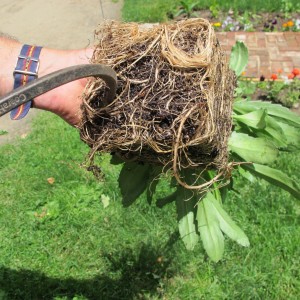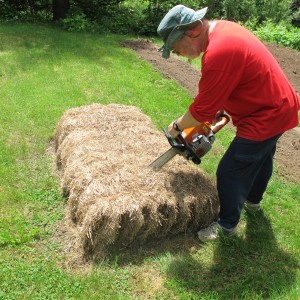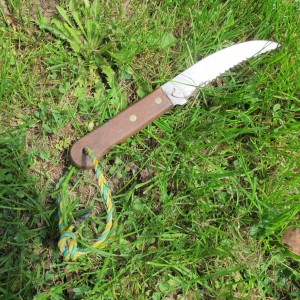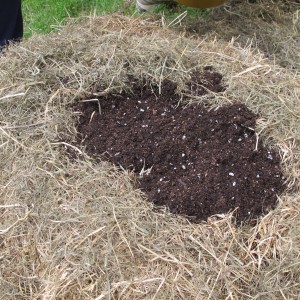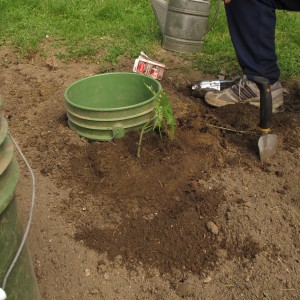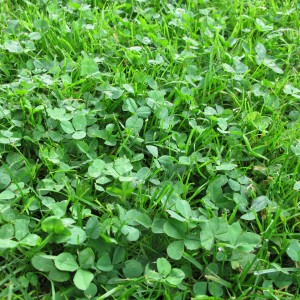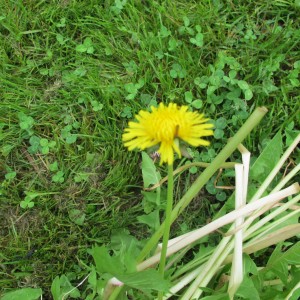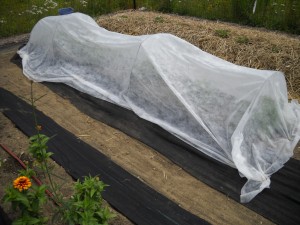Planting Flowers
I love flowers, all kinds of flowers. I probably spend more than I should on seeds, annual flowers in 6-packs, 4-inch pots of trademarked annuals at $5 a pop, perennials, and flowering trees and shrubs. I can get a “runner’s high” just by installing flowers in a new garden space. When I went outside on June 17 with a notebook and a camera, I had 57 species of flowers in bloom, and many more on the way.
I’d guess I planted my first flowers when I was five. Probably some sunflower or morning glory seeds at my Grampy’s home in Spencer, Massachusetts. I spent part of every summer with him from the time I was six until he died on my twenty-first birthday in April of 1967.
But having nice flower beds is more than just buying flowers. Soil preparation and planting make the difference between “bodacious” and “barely bumbling by”. My grandfather was an organic gardener long before it was fashionable, and he taught me how to grow things well by example. He made compost and used it to nourish his soil – and his plants.
Soil can almost always be improved by adding compost. I buy it by the truck load because even the most dedicated gardener rarely has enough. Unless you quit your day job to work on your compost pile, you’ll need to buy compost. It’s rare that you can make enough from left over kitchen scraps and garden waste. For small projects, bagged compost is fine, but most garden centers and many dairy farmers sell it by the pick-up truck load at a reasonable cost.
When preparing a new bed I weed it, and then add 2 to 6 inches of compost on top and mix it in everywhere. This also loosens the soil, getting it ready for plants that have fine root hairs that do the work of penetrating the soil to get moisture and minerals. Soil needs to be loosed to a depth of at least 8 inches, so a garden fork is a good tool to use.
Even if the soil is already dark and rich, I still add a shovel of compost to the planting hole. Perennials get some organic fertilizer, too – half a cup or so in an 18-inch diameter planting hole. Many annuals like lean soil (with little nitrogen, a key ingredient of fertilizers) – so I don’t generally give them any fertilizer. And I don’t fertilize trees and shrubs at planting time – I don’t want them to put on much new growth their first year. And Mother Nature grows tree just fine without fertilizer, you know.
I like organic fertilizers because they provide lots of different minerals that are not present in chemical fertilizers, and they release their nutrients slowly. Pro-Gro is a good one made in Vermont, and Garden-Tone is another nice one. Be careful not to add too much chemical fertilizer if you go that route – it can burn root hairs.
If you’re planting something that has roots that are tangled up or circling the root ball, you will need to loosen them – either with your fingers, or with a hand tool. I like the CobraHead weeder (www.CobraHead.com) for it – it’s my steel finger. At this time of year annuals that come in 6-packs are notorious for roots that are all tangled up. I don’t worry about breaking a few roots in the process of teasing them apart – that will just stimulate them to grow. If you just plop a plant with tangled roots into the soil, the plant might never figure out how to get its roots out into the soil.
Be sure to read the planting guide on the tag from the nursery. Full sun is 6 hours of sun or more each day. Part shade means morning sun, but not hot afternoon sun, or sun filtered through a light canopy of leaves. You can grow full sun flowers in part sun, but they will not flower as much.
Grampy was frugal. He loved his garden, but he didn’t go to garden centers to buy plants – but of course, there really weren’t many back in the fifties and sixties. He started much from seed, and he divided and shared perennials with others, and I imagine he got plants from friends, too.
But if you get flowers from friends, be sure you are not getting the roots of noxious weeds with your gift plant. Study the roots carefully, and pull out anything that is not attached to your new perennial. If your friend’s garden has goutweed, don’t accept any plants, especially iris (which seems prone to bringing goutweed roots tangled in its own). Color is a good way to identify weed roots – they are often different than roots of a perennial flower.
My older sister, Ruth Anne, quoted Grampy as saying, “When you move a plant, dig it up enough soil with it so that it will remember where it came from.” That’s good advice. Soil differs from location to location, and the microbes that favor a perennial at my house might not be present at yours – unless you introduce them.
Lastly, water! New plants need soil that is lightly moist. Check your plants daily, and create a moat of soil around the plants to catch your water, especially on hillsides. Be good to your flowers, and they will reward you handsomely.
Henry is a gardening consultant, coach and the author of 4 gardening books. His web site is www.Gardening-guy.com.
Gardening with a Chain Saw
Bill Waste of Lyme, NH likes to say he gardens with a chain saw. Bill is a good humored fellow, and likes to joke. But I’ve seen him use the chain saw to get a growing bed ready to plant, so his claim is, at least partially, legitimate. What Bill was doing in the vegetable garden with his chain saw was preparing straw bales for planting.
Bill lives on a hill high above the Connecticut River in Lyme, NH with a great view, but limited space for gardening. He is surrounded by trees and the property has rocky soil that would daunt even a hard-working pilgrim. This was sheep farming country for good reason – growing vegetables is hard work in rocky soil. But each year Bill grows tomatoes, basil, pumpkins and squash. This year and last he planted his squash and pumpkins in hay bales.
If you lack good soil, or have invasive weeds that terrorize your garden plot, you might want to think about growing some vegetables in hay bales, too. It’s easy, and you don’t really have to have a chain saw. Bill explained to me that he places three hay bales side-by-side to let them season – 5 weeks is a minimum, he said. He sprinkles about a cup of organic blood meal on the top of each bale to provide nitrogen to the hay, and waters it in well – encouraging the blood meal to penetrate the hay. The hay then begins to ferment, and the blood meal provides nitrogen for the microbes that are beginning to break down the hay.
This first step of seasoning the hay is important, Bill told me, because it gives off considerable heat. Enough heat so that seeds or plants might be killed after planting. As any farmer can tell you, moist hay can occasionally generate enough heat to start a fire by spontaneous combustion. In tests I conducted some years ago, a compost pile can attain temperatures of 130 to 165 degrees Fahrenheit, and grass seed will not germinate after a few days at those temperatures.
But back to the chain saw. After 5 weeks or more outdoors, the hay bales are ready to plant. Bill uses the chain saw to carve out a planting cavity that he fills with soil. The cavity is roughly 6 by 12 inches, and 6 inches deep. I asked if I could prepare one planting hole with a knife, and he let me. I used a 6-inch long serrated knife that I got from Lee Valley tools called a root knife. It was a little slower than Bill’s chain saw, but it did the job. You could do it with a steak knife, I suppose.
After carving out the cavity, Bill fills it with potting soil and a little organic fertilizer. He plants 5 pumpkin or squash seeds in the potting soil, waters well, and steps back, ready for Mother Nature to take over. There are no weed seeds in the potting mix, and the only work that Bill needs to do is make sure the bale does not dry out. If all 5 seeds germinate, he thins out 2 plants.
Although one could grow almost anything in a hay bale, Bill recommends vines, since they can spill over the sides and stretch out across the garden. The only down side I can see is that you must be willing to let the vines grow over the lawn- which cannot easily be cut while the plants are growing. One could, I suppose, put down black plastic or mulch to keep down grass and weeds as the vines grow.
Bill is always looking for ways to save energy – his, that is. He has come up with a method of growing tomatoes that allows him to go away for a week if he wants, without letting his tomatoes suffer from lack of water. It requires access to lots of plastic buckets, which he has. Some fast food places give them away, and some building contractors have excess buckets that sheet rock “mud” comes in.
What Bill does is bury 5-gallon pails in his garden, leaving just a couple of inches above ground. These are his water reservoirs, and his tools for getting moisture down deep in the ground. Instead of surface watering every day in August when his garden is dry and thirsty, he just waters once a week by filling the buckets. The trick? He has drilled a series of eighth-inch holes in the buckets so that water leaks out to the soil after he fills them.
Around each bucket Bill plants 3 tomato plants, each just as close to the bucket as he can. The buckets have three sets of 6 or 7 small holes, each in an inverted “Y” pattern. The water leaks out in an hour or so, but it gets water where he wants it: down deep.
Each of us has a different approach to weeding, watering, planting. We figure out what works best. I doubt I will ever bury buckets for watering my garden, but if you have dry, sandy soil, you might want to. And hay bales? I’ll probably try it.
Henry’s Web site is www.Gardening-Guy.com. He can be reached at henry.homyer@comcast.net. He is the author of 5 books.
Spring Lawn Care
I love lawns. Not big lawns, and they don’t need to be pure Kentucky bluegrass, either. I love a little bit of mowed green that has some grass and clover; it can have a few dandelions or bluets or violets, too. I can live with Creeping Charlie (also called ground ivy or by its scientific name, Glechoma hederacea). Overall my philosophy is this: if it’s green and you can mow it, it’s a lawn. Only thistles and other sharp things need to be dug out- but never nuked with chemicals.
Despite that philosophy, people often remark on how lush and thick my lawn is, and how nice it feels underfoot. Having a nice lawn is easy if you follow a few simple rules.
First, stop worrying about it. And certainly never add any chemicals to it. Weed-‘n’-feed formulas kill off not only the broad-leafed plants like dandelions, they also diminish the biological activity in the soil. I want a healthy soil full of microbes (including bacteria and fungi) and know that many microbes are killed or adversely affected by chemicals.
Chemical fertilizers are made of salts of nitrogen, phosphorus and potassium. These have the ability to dry out and kill microbes. And of course if your product includes chemicals for killing moss, weeds, fungi or insects, all those chemicals add to the killing power. Your soil cringes when you load up the spreader with weed-‘n’-feed.
If you want to have a good healthy lawn, you need good healthy soil. It needs about 6 inches of reasonably good soil that drains well (so as not to drown the lawn grasses) but is not so sandy that it dries out in an afternoon. Cut and peel back a one-foot square piece of sod after a rainstorm, and look at the soil. Grab a handful of soil. Does it form a cylinder in your hand when you squeeze it, and hold its shape when you open your fingers? If so, you have clay, or a clay-based soil.
If you perform the squeeze test on sandy soil, it will crumble apart when you open your fingers. When you rub the soil between your fingers, you will feel sharp grains of sand. But if you have a nice loam, the soil with be dark and the cylinder will fall apart if you touch it with a finger.
If you are not happy with your lawn, I suggest getting your soil tested. The Extension Service in most states will have on-line instructions on how to take a soil sample, and where to send it. Some garden centers have kits for sale. Find out what kind of soil you have, what it needs, and if your soil pH is in the right zone.
Soil pH is a measure of how acidic or alkaline your soil is. Lawns do best when the soil pH is near neutral (which is 7.0) or slightly acidic. Our rain is acidic, and neglected soils – including most lawns – have soil that is pretty acidic. You can fix this easily by adding limestone to the lawn, and a pH test will tell you how much to add to balance it out. If your soil is too far from neutral, some soil minerals will become unavailable to the grass plants, even if the minerals are there. You can add limestone at any time, though most lawn experts recommend the fall so that it will have time to do its work before spring growth begins.
The other additive that helps an anemic lawn is compost or organic matter. Good crumbly compost can be flung around the lawn with a shovel and then raked out to provide even coverage. Doing that now would help. Earthworms in a healthy lawn will be more than willing to eat that compost and then excrete the nutritious ingredients into the soil.
Earthworms, fungi and bacteria will also help you improve your lawn by breaking down your grass clippings. Those clippings will add organic matter and enrich your soil. So cut your lawn regularly – avoiding a thick layer of clippings that needs to be bagged or raked.
Lawn height is critical for a good, easy-care lawn. Get out of the golf course mindset. This is a lawn, not a putting green! I set my mower, generally, one notch down from the highest setting. Right by the front door I keep it a little shorter at times.
Why keep your lawn long? Your lawn is made of millions of plants, and each one can only create a healthy root system if you let it have enough blade to create its own food by photosynthesis. Too short? The roots will be stunted, and the lawn will not be healthy. And the taller the grass, the more it can shade out annual weeds and crabgrass.
Think about it: if there were daffodils that we could mow down only to have them bloom again, we would pay big bucks for them. But call those yellow flowers dandelions, and it’s war. I hope you’ll re-think your position about lawn chemicals if you’re in the weed-‘n’-feed school. Diversity of plant types in the lawn helps to create a lush, lovely green space.
Henry Homeyer is a garden designer and the author of 4 gardening books and a children’s chapter book. His Web site is www.Gardening-Guy.com.
Vegetable Gardening
I planted much of my vegetable garden early this year. Living in a cold spot, I usually wait until June 10 to plant frost and cold-sensitive plants. But lured by perfect warm weather I planted most of my tomatoes on Memorial Day weekend. The soil was 60 degrees and sun strong. Then the weather turned chilly and wet. My tomatoes will survive this, and I can always cover them if there is threat of frost. Still, after all these decades, I should have more patience. Tomatoes, peppers, eggplants, cukes, squash: all these like hot weather.
I did not plant my vine crops early, however. I like to start cukes, squash and pumpkins indoors in May in 4-inch pots, growing them under lights until they have vines a foot long with several leaves. Or sometimes I will buy a few nice big plants. I do this because of the dreaded striped cucumber beetle, a pest that can – and will – eat up a plant’s first 2 leaves in one night. But a bigger plant can survive a few beetle bites without trouble.
Another way to minimize beetle damage on any crop is to cover it with row cover, also called Reemay or Agribon (both are trade names). Row cover is a thin woven fabric that breathes and allows more than 90% of the sun’s light to pass through – without burning your plants the way clear plastic would. Got trouble with little green caterpillars on your broccoli? Cover it up. Rain will pass through it, too.
Although you can just lay row cover on your plants, I like to stretch it over wire hoops that are sold for the purpose. It gives the plants room to grow. In either case, you must seal the edges or some critters will crawl under for a free lunch. You can use earth staples sold for the purpose, or just use those stones that Mother Nature pushes up out of the soil every winter.
Row cover holds in some heat, which is good at this time of year. But if you need insect pollination – all the vine crops need it – you must take off the covers when they flower or hand pollinate, which is time consuming. I sometimes leave row cover on eggplants all summer as they are wind pollinated.
Thinning plants started outdoors by seed must be the most tedious of all garden tasks. Carrots, lettuce, rutabagas, beets? All need to be thinned for best results. Beets and carrot babies are good to eat if you wait until the end of the month of June. I try to have them thinned to one inch apart by the Fourth of July, with a wider spacing a month later.
Beet greens are a classic early summer dish that I like served with a sprinkling of gourmet rice wine vinegar instead of the calorie-packing butter that I use on my asparagus. And just a reminder, don’t keep picking asparagus for more than 3 weeks. Oh, it’s tempting to keep picking the spears that pop up to replace those you’ve eaten. But the greens are needed to feed the roots, and picking for too long will cause the patch to run down.
My asparagus patch produced well this year, its third, and I am rewarding it with regular weeding, a light top-dressing of organic fertilizer and a little compost. Then I will cover the compost with a layer of wood chips to minimize the need for weeding later on this summer.
Last fall I covered up my wide raised (mounded) vegetable garden beds with hay, straw or fallen leaves after cleaning out most of the weeds. This really minimized my work this spring. I pushed off the winter cover of mulch into the walkways in early May, which kept weeds from starting up there. The sun warmed the soil, spawning some weeds. But I pulled them out or sliced them off before they got established, and then planted without rototilling.
I know some gardeners who love their rototillers as much as they love their spouses. They do create a lovely-looking bed, and they make all the weeds “disappear”. But if you chop up witch grass or perennial weeds, each piece may well produce a new plant in a few weeks.
Many weeds have what I call ‘photo-triggers’. This means that they need some light to know it is time to wake up and grow. Buried down 4 inches, the seeds can sleep for years. Turn them up with a rototiller and they germinate. So at planting time I try to minimize how much I disturb the soil. I use an ancient 4-tined potato hoe and my CobraHead weeder (www.CobraHead.com) to do most of the soil work.
We’ve all heard of the “runner’s high” – a feeling of well being from running. Sometimes I get a “gardener’s high” instead. Planting a garden will do it for me. I just wish I got the same feeling after an afternoon of weeding – instead of a tired back.
Henry Homeyer’s Web site is www.Gardening-Guy.com. He is the author of 4 gardening books, and a children’s fantasy-adventure, Wobar and the Quest for the Magic Calumet.



